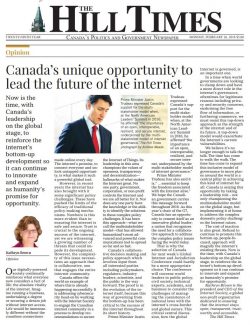Our digitally-powered society continually reinforces what everyone now considers a fact of life: the absolute vitality of the internet. Imagine running a business, undertaking a degree or securing a dream job without internet access. Life would be immensely different without the countless connections made online every day. The internet’s promise, to connect everyone and unlock untapped opportunity, is what makes it such a powerful global tool.
However, in recent years the internet has also brought with it some significant policy challenges. These have pushed the limits of the efficacy of traditional policy-making mechanisms. Nowhere is this more evident than in ensuring the internet is safe and secure. Trust is crucial to the ongoing success of the internet, yet we are witnessing a growing number of threats that could impede its development. However, the complexity of this issue necessitates an approach that is collaborative, one that engages the entire internet community.
Canada offers the world an example of where this is already happening successfully. It is addressing cybersecurity head-on by working with the Internet Society to engage the Canadian internet community in a process to develop recommendations to secure the Internet of Things. Its leadership in this area champions the values of openness, transparency and decentralization—hallmarks of what makes the Internet great. No one party, government, corporation, or non-profit controls the Internet and we are all better for it. Nor does any one party have the knowledge or the ability to identify the solutions to these complex policy challenges. It has been this approach—what we call the multistakeholder model—that has allowed humankind’s most advanced and powerful communications tool to spread so far and so fast.
Canada’s collaborative decision making and policy approach which involves input from all interested parties including policymakers, regulators, industry leaders, scientists, and the public is the way forward. The proof is in the evolution of the internet itself, because this way of governing from the bottom-up has been critical to the success of the internet throughout its short history.
Prime Minister Justin Trudeau expressed Canada’s support for the multi-stake-holder model when, at the North American Leaders’ Summit in 2016, he affirmed “the importance of an open, interoperable, resilient, and secure inter-net, underpinned by the multi-stakeholder model of internet governance.”
Prime Minister Trudeau has also said it is, “ … essential to keep the freedom associated with the Internet alive.” We hope the Canadian government carries this message forward throughout 2018. As this year’s chair of the G7, Canada has an opportunity to cement itself as an innovative global leader; a nation that recognizes the need for a collaborative approach to address the complex policy issues facing the world today.
That is why the selection of Canada for next week’s Global Internet and Jurisdiction Conference could hardly be a more appropriate choice. The conference will convene world leaders in public policy, civil society, technical experts, academia, and business to consider the challenges of managing the coexistence of national laws with the internet’s cross-border and global nature. This critical central discussion, how the global Internet is governed, is an important one.
In a time when world governments are looking to clamp down and have a more direct role in the internet’s governance, oftentimes for legitimate reasons including privacy and security concerns, enshrining the free flow of information, or furthering commerce, we must resist this top-down approach as the strength of the internet and of its future. A top-down model would exacerbate the Internet’s current vulnerabilities.
We believe it’s no longer enough to talk the talk. The time has come to walk the walk. The time has come to expand this inclusive model of governance to more places around the world is a central pillar in achieving this kind of internet for all.Canada is seizing this opportunity by taking a leadership role – not only championing the multistakeholder model on the global stage, but implementing it at home to address the complex domestic policy challenges the Internet raises.
The cost of inaction is also great. Refusal to continue to promote this bottom-up, people-focused, approach will magnify the internet’s existing threats. Now is the time, with Canada’s leadership on the global stage, to reinforce the in-ternet’s bottom-up development so it can continue to innovate and expand as humanity’s promise for opportunity.
Kathryn Brown served as the president and CEO of the Internet Society, a global non-profit organization dedicated to ensuring that the internet stays open, transparent, trust-worthy and accessible.
This opinion piece was originally published in the Hill Times on February 26, 2018.
